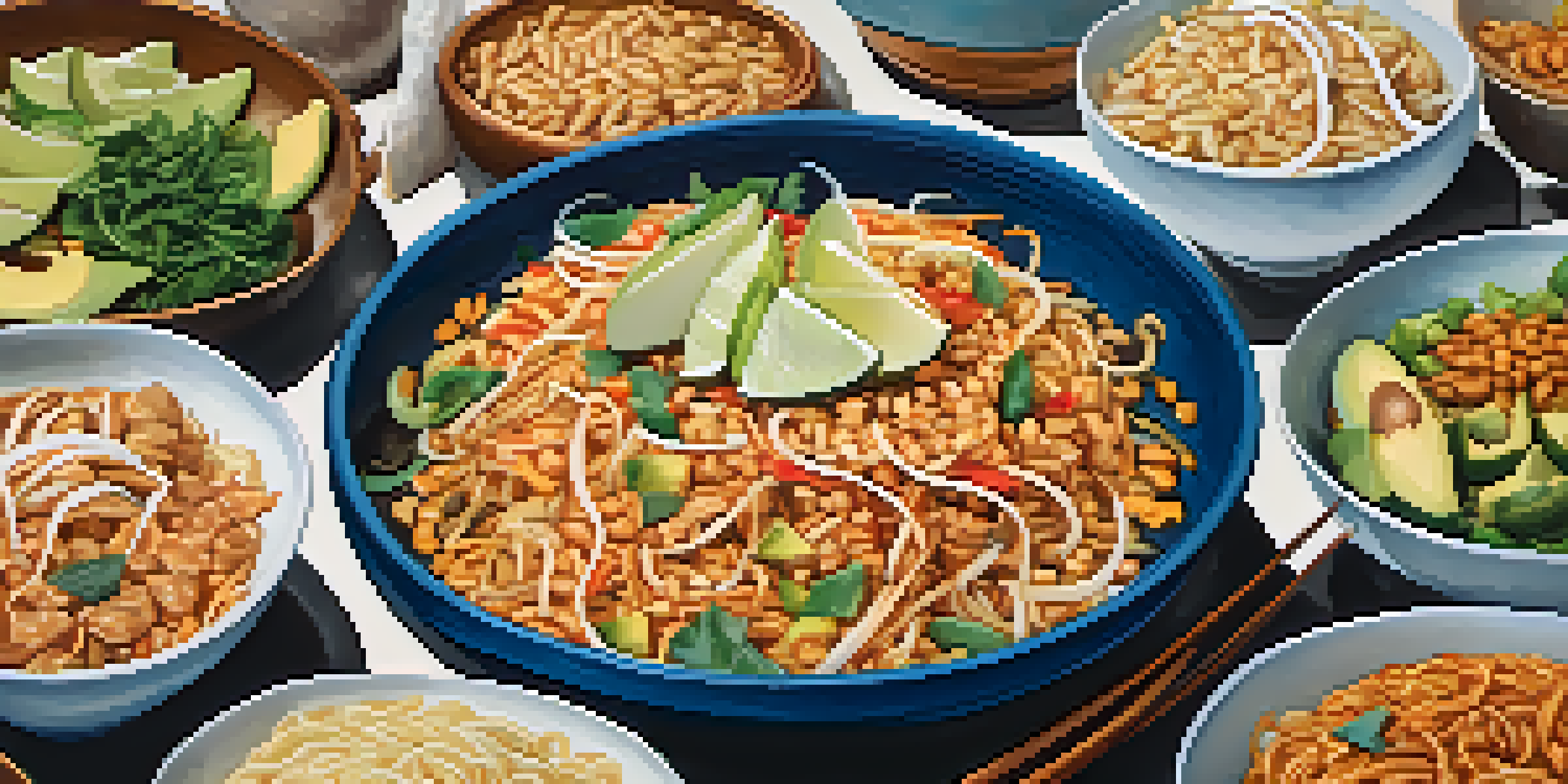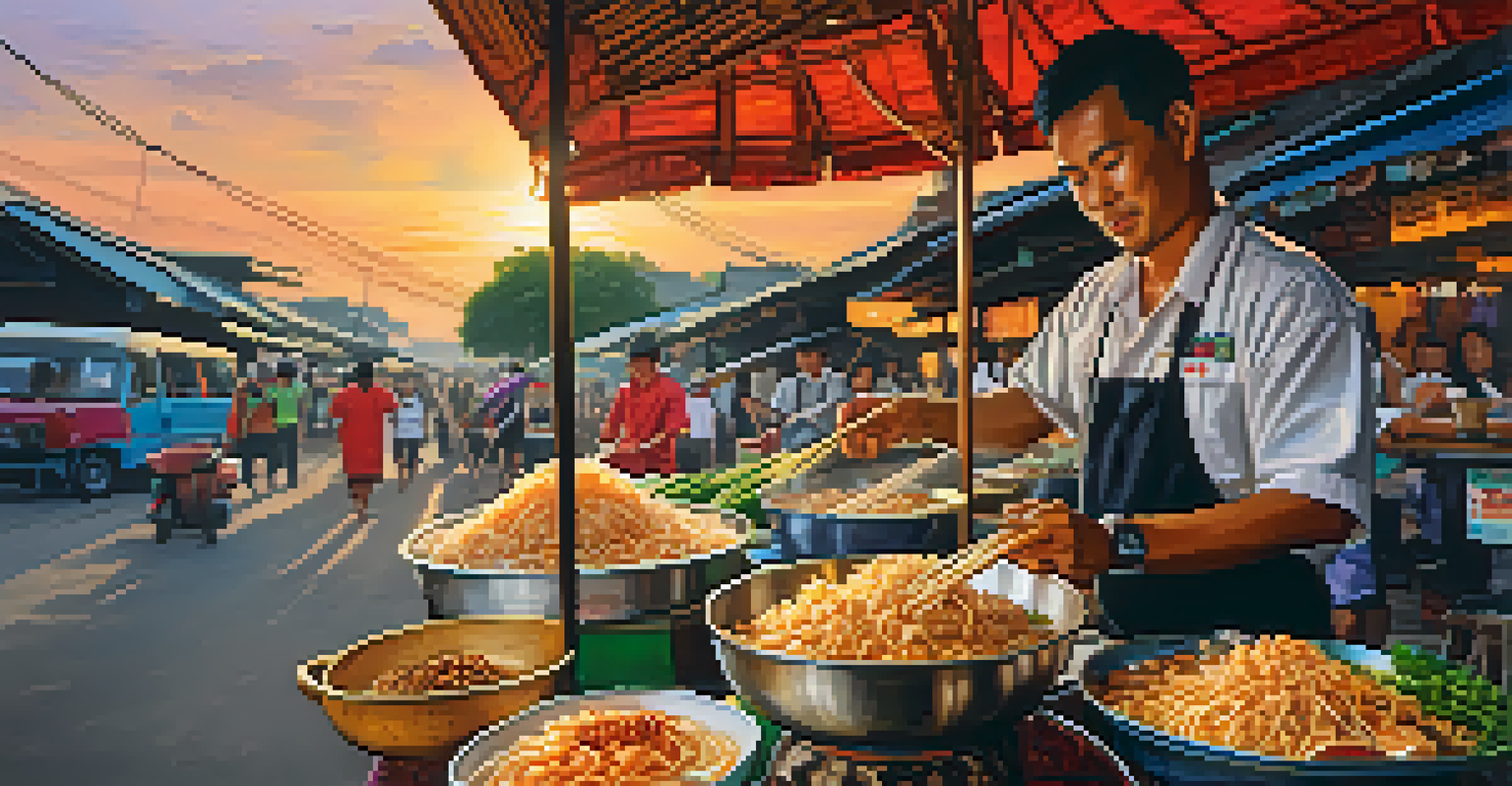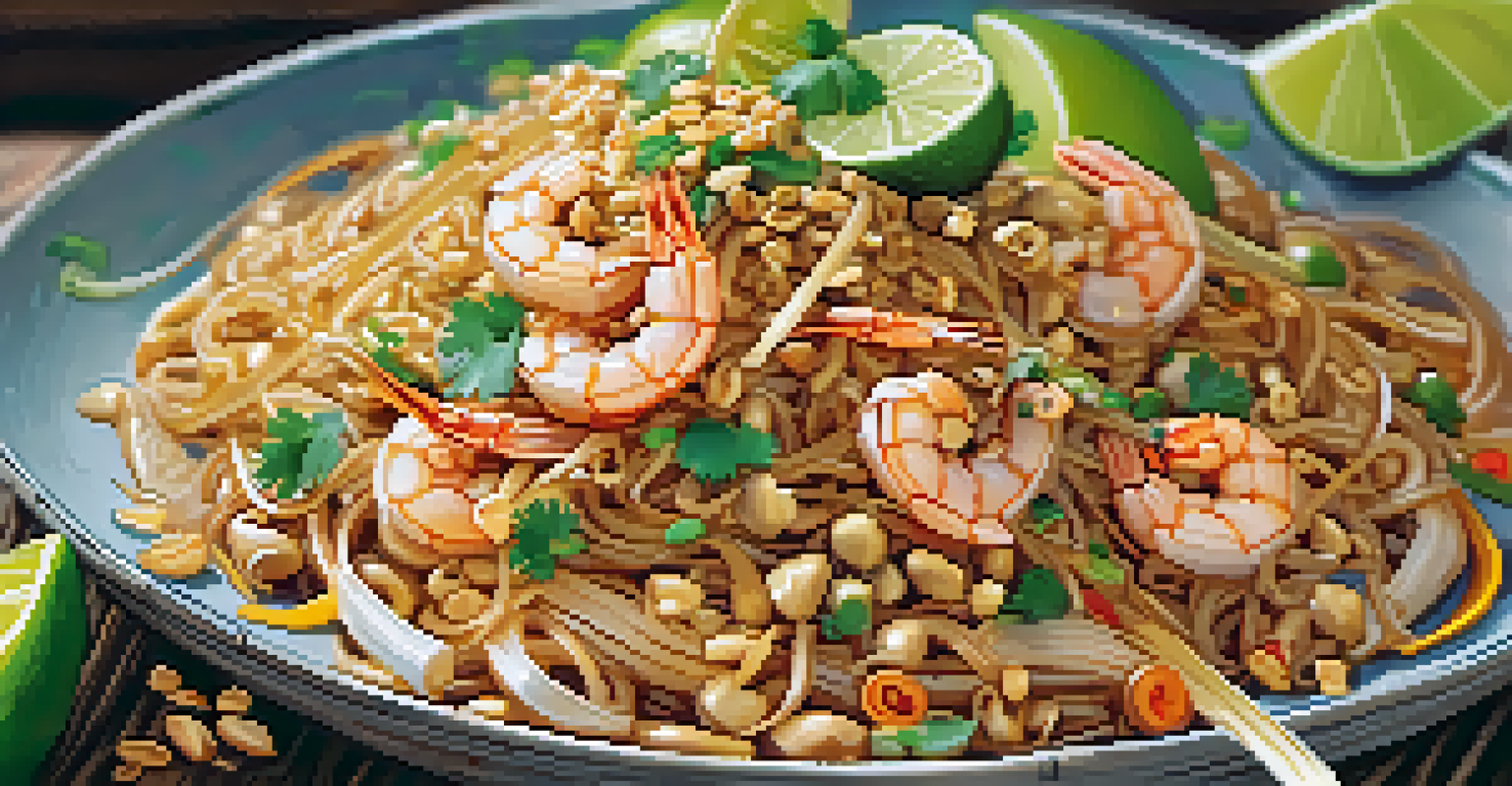The Origins of Pad Thai: A Culinary Journey Through Time

Tracing the Historical Roots of Pad Thai
Pad Thai, a beloved dish worldwide, has a history that dates back centuries. Its origins can be traced to the early 20th century when it was introduced as part of a national campaign to promote Thai cuisine. The dish combines rice noodles, proteins, and vegetables, creating a delightful fusion of flavors that reflects Thailand's diverse culinary landscape.
Food is our common ground, a universal experience.
Interestingly, Pad Thai was also influenced by the Chinese stir-fry cooking methods, which were adapted to suit local tastes. The incorporation of ingredients like tamarind, fish sauce, and peanuts showcases the unique blend of cultural influences that shaped this dish. Over time, it evolved into a staple food item, enjoyed by locals and tourists alike.
Today, Pad Thai is often seen as a symbol of Thai street food culture, embodying the spirit of communal dining and sharing. The dish's rich history is a testament to the adaptability of Thai cuisine, making it a beloved favorite around the globe.
The Role of King Rama VI in Popularizing Pad Thai
King Rama VI played a pivotal role in promoting Pad Thai during his reign in the early 1900s. At a time when Thailand was modernizing, the King encouraged the adoption of this dish as a national food, aiming to unify the country through its cuisine. This initiative not only elevated Pad Thai’s status but also helped foster national pride among the Thai people.

The King’s efforts to popularize Pad Thai coincided with a broader campaign to reduce rice consumption. By promoting the use of rice noodles, he aimed to combat rice shortages and encourage a more sustainable diet. This strategic move not only contributed to the dish’s success but also transformed Pad Thai into a culinary icon.
Pad Thai's Rich Historical Background
Originating in the early 20th century, Pad Thai reflects Thailand's diverse culinary influences and has evolved into a beloved global dish.
Through royal endorsement, Pad Thai quickly gained popularity in urban areas, particularly in Bangkok. Street vendors began to emerge, serving the dish to eager customers, and by mid-century, Pad Thai had firmly established itself as a quintessential part of Thai culinary culture.
Ingredients That Make Pad Thai Unique
The magic of Pad Thai lies in its unique combination of ingredients, each contributing to its distinct flavor profile. Staples like rice noodles, tofu, shrimp, or chicken form the base of the dish. However, it’s the addition of tamarind paste, which imparts a tangy sweetness, that truly sets Pad Thai apart from other noodle dishes.
Cooking is like love. It should be entered into with abandon or not at all.
Moreover, the dish is often garnished with crushed peanuts, bean sprouts, and lime wedges. These toppings not only enhance the flavor but also provide a delightful crunch and freshness. The balance of flavors—sweet, salty, sour, and spicy—creates a harmonious experience that tantalizes the taste buds.
As chefs experiment with different variations, Pad Thai continues to evolve. Vegetarian and vegan options have gained popularity, showcasing the dish's versatility and adaptability. This openness to modification keeps Pad Thai relevant and loved by many, ensuring its place in culinary history.
Cultural Significance of Pad Thai in Thailand
Beyond its delicious taste, Pad Thai carries significant cultural weight in Thailand. The dish symbolizes the country's rich culinary heritage and reflects the influence of various cultures—Thai, Chinese, and Indian. Eating Pad Thai is often associated with social gatherings, festivals, and celebrations, making it a beloved comfort food.
Many Thai families have their own cherished recipes, passed down through generations. This personal connection not only preserves the dish’s heritage but also fosters a sense of belonging and identity among the Thai people. Sharing Pad Thai with friends and family is a way to celebrate traditions and create lasting memories.
Cultural Significance in Thailand
Pad Thai symbolizes Thailand's rich culinary heritage and is a staple in social gatherings, fostering a sense of identity among the Thai people.
In recent years, there has been a concerted effort to promote Pad Thai as more than just street food. Culinary schools and chefs are now showcasing the dish's complexity and artistry, elevating it to fine dining. This renewed interest highlights the importance of Pad Thai in the global culinary scene, further solidifying its cultural significance.
Pad Thai: The Global Phenomenon
As globalization has taken hold, Pad Thai has transcended its local roots to become a global culinary phenomenon. It is now featured on menus in restaurants worldwide, from upscale eateries to casual dining spots. This international appeal showcases the dish's versatility and adaptability to different palates.
Pad Thai's rise in popularity can also be attributed to the growing interest in Asian cuisine. Food enthusiasts and travelers are increasingly seeking authentic experiences, leading to a greater appreciation for Thai dishes. As a result, Pad Thai has become synonymous with Thai cuisine, often being the first dish that comes to mind when people think of Thailand.
Social media has played a significant role in this global spread, with food bloggers and influencers sharing their love for Pad Thai. This digital exposure has sparked curiosity and encouraged food lovers to try their hand at making this iconic dish at home, further solidifying its status as a beloved global staple.
Variations of Pad Thai Around the World
While traditional Pad Thai has a distinct flavor profile, variations have emerged in different parts of the world. In the United States, for instance, you might find Pad Thai made with additional ingredients like avocado or served with a spicy peanut sauce. These adaptations cater to local tastes while still paying homage to the original dish.
In Australia, some eateries have introduced a fusion twist by incorporating local ingredients, such as kangaroo or barramundi. This innovative approach not only highlights regional flavors but also attracts adventurous eaters looking for a new culinary experience. These variations demonstrate how Pad Thai continues to evolve and resonate with diverse audiences.
Global Adaptations and Variations
As a global phenomenon, Pad Thai has adapted to local tastes, resulting in diverse variations that maintain its core essence while appealing to a wide audience.
The ability to adapt Pad Thai to different cultures while maintaining its core essence is what makes it a truly global dish. Whether enjoyed in its traditional form or with a modern twist, Pad Thai remains a beloved favorite, connecting people through the universal language of food.
The Future of Pad Thai: Trends and Innovations
As we look ahead, the future of Pad Thai appears bright, with trends and innovations shaping its evolution. Health-conscious consumers are driving the demand for lighter, healthier versions of the dish. Restaurants are responding by offering gluten-free noodles or incorporating more vegetables, catering to the growing interest in nutrition without sacrificing flavor.
Moreover, the rise of plant-based diets has prompted chefs to experiment with creative alternatives, such as using jackfruit or lentils in place of traditional proteins. These innovations not only appeal to vegans and vegetarians but also showcase the versatility of Pad Thai, allowing it to adapt to changing dietary preferences.

As culinary enthusiasts continue to explore the world of Pad Thai, we can expect to see even more unique interpretations. This ongoing creativity ensures that Pad Thai will remain a beloved staple for generations to come, bridging cultural gaps and fostering connections through the joy of eating.